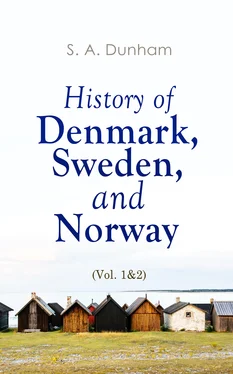S. A. Dunham - History of Denmark, Sweden, and Norway (Vol. 1&2)
Здесь есть возможность читать онлайн «S. A. Dunham - History of Denmark, Sweden, and Norway (Vol. 1&2)» — ознакомительный отрывок электронной книги совершенно бесплатно, а после прочтения отрывка купить полную версию. В некоторых случаях можно слушать аудио, скачать через торрент в формате fb2 и присутствует краткое содержание. Жанр: unrecognised, на английском языке. Описание произведения, (предисловие) а так же отзывы посетителей доступны на портале библиотеки ЛибКат.
- Название:History of Denmark, Sweden, and Norway (Vol. 1&2)
- Автор:
- Жанр:
- Год:неизвестен
- ISBN:нет данных
- Рейтинг книги:5 / 5. Голосов: 1
-
Избранное:Добавить в избранное
- Отзывы:
-
Ваша оценка:
- 100
- 1
- 2
- 3
- 4
- 5
History of Denmark, Sweden, and Norway (Vol. 1&2): краткое содержание, описание и аннотация
Предлагаем к чтению аннотацию, описание, краткое содержание или предисловие (зависит от того, что написал сам автор книги «History of Denmark, Sweden, and Norway (Vol. 1&2)»). Если вы не нашли необходимую информацию о книге — напишите в комментариях, мы постараемся отыскать её.
The Pagan Age:
Denmark (B.C. 40 to A.D. 1014)
Sweden (A.C. 70 to A.D. 1001)
Norway (about A.C. 70 to A.D. 1030)
Maritime Expeditions of the Northmen During the Pagan Times:
In England, France, and Ireland
Maritime Expeditions of the Northmen During the Pagan Times:
In the Orkneys, the Hebrides, Iceland, Greenland, North America, Russia, etc.
Cosmogony and Religion of Scandinavia
Introduction of Christianity Into Denmark and Sweden
The Middle Age:
Denmark (1014-1387)
Norway (1030-1387)
Sweden (1001-1389)
History of Denmark, Sweden, and Norway (Vol. 1&2) — читать онлайн ознакомительный отрывок
Ниже представлен текст книги, разбитый по страницам. Система сохранения места последней прочитанной страницы, позволяет с удобством читать онлайн бесплатно книгу «History of Denmark, Sweden, and Norway (Vol. 1&2)», без необходимости каждый раз заново искать на чём Вы остановились. Поставьте закладку, и сможете в любой момент перейти на страницу, на которой закончили чтение.
Интервал:
Закладка:
|1013 to 1014.|
In 1013 Sweyn arrived, with new reinforcements, to take possession of the whole island. On landing in the north, the earl of Northumberland and the whole province submitted. Proceeding to the south, Oxford, Winchester, Bath, with all the towns of the west, and all the great thanes, sent in their allegiance. For some time London held out, because Ethelred was in it; but that doughty hero, having ascertained that duke Richard of Normandy would receive him for the sake of his wife, precipitately fled to Rouen, leaving his capital and kingdom in the hands of the invaders. Sweyn was king of England; and he used the title, though, owing to the short residue of his life, he was not crowned. That he exercised all the rights of sovereignty, fully as the Saxon kings had ever done, is admitted by our own historians. His reign is said to have been one of severe exaction. He died at Gainsborough in one year after his elevation, under circumstances of suspicion. The northern annalists declare that he was killed by prince Edward, afterwards the Confessor; but no English authority confirms the report. This was not the work of Edward; but it might be that of Edmund Ironside. [115]
Many years before his death Sweyn probably reverted to Christianity, and persevered in it unto his death. But whether pagan or Christian, he was a ferocious warrior and a stern king. With natural talents of a high order, with indomitable courage, with unwearied activity, he obtained advantages which none of his predecessors had enjoyed. We have already alluded to the diversion which his son, with Olaf Trygveson, king of Norway, created in favour of England. After the death of that hero (1000), he seized a portion of Norway, while the Swedish king seized another; and this augmentation of his power no doubt rendered him more able to conquer England. [116]
CHAP. II.
SWEDEN.
Table of Contents
A.C. 70 to A.D. 1001.
UNCERTAINTY AND CONTRADICTION IN THE CHRONOLOGICAL SERIES OF KINGS EXPLAINED BY THE FACT THAT THE GOTHS AND SWIONES WERE UNDER DISTINCT RULERS—HENCE THEIR CONFUSION.—THE YNGLINGS, OR SACRED FAMILY OF ODIN, REIGN AT UPSAL.—KINGS OF THAT RACE: ODIN—NIORD—FREYR—FREYA—FIOLNER—SWEGDIR—VANLAND—VISBUR—DOMALD—DOMAR—DYGVE—DAG—AGNE, ETC.—FATE OF THE PRINCES OF THIS HOUSE, OF WHOM MOST DIE TRAGICALLY.—LEGEND OF AUN THE OLD.—INGIALD ILLRADA.—CONQUEST OF SWEDEN BY IVAR VIDFADME.—GOTHIC KINGS FROM GYLFO TO IVAR VIDFADME.—KINGS OF THE SWEDES AND THE GOTHS.
In the Introduction to the present volume we have added the tabular list of kings by archbishop Joannes Magnus, as illustrative of the difficulty which must accompany all researches into the ancient history of Sweden. [117]The exploits of those kings, their chronological order, their very names, rest under a deep cloud. Where, indeed, no two authors agree—where the names, not merely of two or three sovereigns, but of nearly one half, are as different as the actions ascribed to them—what can be inferred but this, that little dependence is to be placed on any one of them? Compare, for example, the list given by the archbishop with that which modern Swedish critics approve [118]; and what must be the reader’s surprise to find—110 in the former case, and 37 in the other; the names, too, for the most part, dissimilar as the number! If we take that given by the authors of our Universal History [119], we shall, indeed, have some approximation in respect to the number, but little in regard to the names, of the kings. Other lists might be produced equally contrasting with the one contained in the Norwegian authorities. Whence this diversity, which modern historians have pronounced to be hopelessly irreconcileable? It arises from a very simple cause. When the Swiones, the attendants of Odin—his companions from his Asiatic kingdom—arrived in the north, they found a Gothic tribe, the Gothones, under Gylfo their king, seated along the maritime coast, and extending to the centre of Sweden. How long this tribe had been settled there when the Swiones arrived would be vain to inquire. By what means Odin and his followers obtained a portion of the country, and established the seat of his new empire at Upsal, has been already related. Here, then, were two distinct tribes, the Gothones or Goths, and the Swiones or Swedes, to say nothing of the original tribes, or, at least, fragments of those tribes, who had been located in these regions many centuries before the arrival of the Goths. Now the kings whom Joannes Magnus, Torfœus, Loccenius, the authors of our Universal History, and other writers enumerate, were the kings of the Goths and Swedes, while those contained in the Landfedgatal, the Heimskringla, and other Icelandic authorities, were sovereigns of the Swedes only. That the two people, and, consequently, the districts which they inhabited, were for many centuries under distinct rulers, is one of the best ascertained facts of history. The former called themselves kings of the Goths, or of Gothland, only; the latter, now kings of the Swedes, now of Upsal. This distinction was not only observed from the very dawn of their history, but is at this day preserved in the title of the monarch, who is styled “King of the Swedes and of the Goths.” Hence the two lists of kings—the two kingdoms—the distinction of history in both; all which have hitherto been confounded, and so completely as to baffle the keenest criticism. Not that the king of the one people was not sometimes the king of both. This could not be otherwise, when two conterminous nations, jealous of each other’s prosperity, were eager for the ascendancy. The superiority, no doubt, was assumed by the sovereigns of the divine race, the descendants of Odin; but those of Gothland were sometimes the rulers, and hailed as monarchs of the Swedes. On the other hand, the kings of the Swedes—those who reigned at Upsal—were still more frequently victors over their Gothic neighbours. Hence the confusion which, notwithstanding the important distinction we have been so careful to indicate, will often be found in the regal lists of this country. [120]
|A.C. 40 to A.D. 14.|
We commence with the hallowed race, the pontiff kings of the Swedes, who reigned at Upsal. On the death of Odin, Niord succeeded, as prophet, priest, and king, in the capital of Sigtuna. It was then, no doubt, the head of a very small state. Many were the kings which held Sweden at this time: besides Gothia, which was subject to chiefs, who, in the sequel, were generally at war with the Swiones, each province had its king. Several of the states were bound in alliance with Niord. Odinsey, in Fionia, was held by a chief of this nature; Skiold, the son of Odin, reigned at Ledra, in Zealand; Freyr was the pontiff chief of Upsal; Heimdal was over the temple at Hemenbiorg; Thor was at Thrudvang, and Balder at Breidablik. [121]And though Scania was a possession of the Goths, and not yet subject to the Danish chiefs, it appears to have been held by some one of the Asser. The reign of Niord was a happy one; the gifts of nature were extraordinarily abundant, and the benefit was referred to his influence with the gods. Before his death he wounded himself as Odin had done. After it, his body was laid on the funeral pyre, and he was long worshipped as a deity. The sceptre was now transferred to Freyr , the son of Niord. His reign, too, was prosperous, and he was the idol of his people. He it was who built the great temple at Upsal, and made it the seat of his government, in preference to Sigtuna. Here he received the tribute furnished by his subjects; hence the progressive enrichment of that place. Universal peace distinguished his administration. He was held in greater esteem than his predecessors, and his surname of Yngve became the proudest distinction of his descendants, who were thenceforth called Ynglings . His death—we know not for what reason—was concealed for three years; the only reason assigned is, that a magnificent tomb was erecting for him during that period. His son did not immediately ascend the throne of the Swedes; there was Freya , the last of the divine personages who had accompanied Odin from Asia to the north. She was celebrated in her life, and still more after her death: her body was not burned on the funeral pyre, because it was believed she had returned to the gods; and her statue, as everybody knows, in conjunction with those of Thor and Odin, long adorned the temple at Upsal. Fiolner [122], the son of Freyr, succeeded. He was contemporary with Frode I., king of Denmark. Both were equally inclined to peace, and they lived in perfect harmony. More than once did he visit king Frode at Ledra, whose hospitality was the admiration of that age. But one of his visits proved fatal. Whatever might be his other virtues, sobriety was not of the number; his potations were long and deep; and one night, having occasion to rise, he fell into a huge vessel of mead which was in the cellar, the trap door of which had been incautiously left open. [123]The throne now passed to Swegdir , his son. This prince, accompanied by twelve nobles, went into Asia for the purpose of inquiring into the family and exploits of Odin. He wandered over “Turkland” and Great “Swionia,” the Asheim or Godheim of the Swedes. Here he found many of his own blood. While in the territory of the Vanir [124], he married a lady of that nation, and by her had a son, whom he called Vanland. At the end of five years, he returned to Upsal; but if any reliance is to be placed on tradition, he afterwards took a second journey to those distant regions, and never returned. A wondrous legend has been invented to account for his death. “To the east of Great Fionia,” says Snorro, “there is a large villa called Stein , a rock, from one being placed there so huge, as to equal a house. One evening, after sunset, as the king was about to pass from his cups to his bed, he saw a fairy sitting under that great rock. He and his companions, being excited by wine, ran towards the place, and the fairy desired Swegdir to enter if he wished to converse with Odin. He did enter, and was seen no more.” [125]
Читать дальшеИнтервал:
Закладка:
Похожие книги на «History of Denmark, Sweden, and Norway (Vol. 1&2)»
Представляем Вашему вниманию похожие книги на «History of Denmark, Sweden, and Norway (Vol. 1&2)» списком для выбора. Мы отобрали схожую по названию и смыслу литературу в надежде предоставить читателям больше вариантов отыскать новые, интересные, ещё непрочитанные произведения.
Обсуждение, отзывы о книге «History of Denmark, Sweden, and Norway (Vol. 1&2)» и просто собственные мнения читателей. Оставьте ваши комментарии, напишите, что Вы думаете о произведении, его смысле или главных героях. Укажите что конкретно понравилось, а что нет, и почему Вы так считаете.












